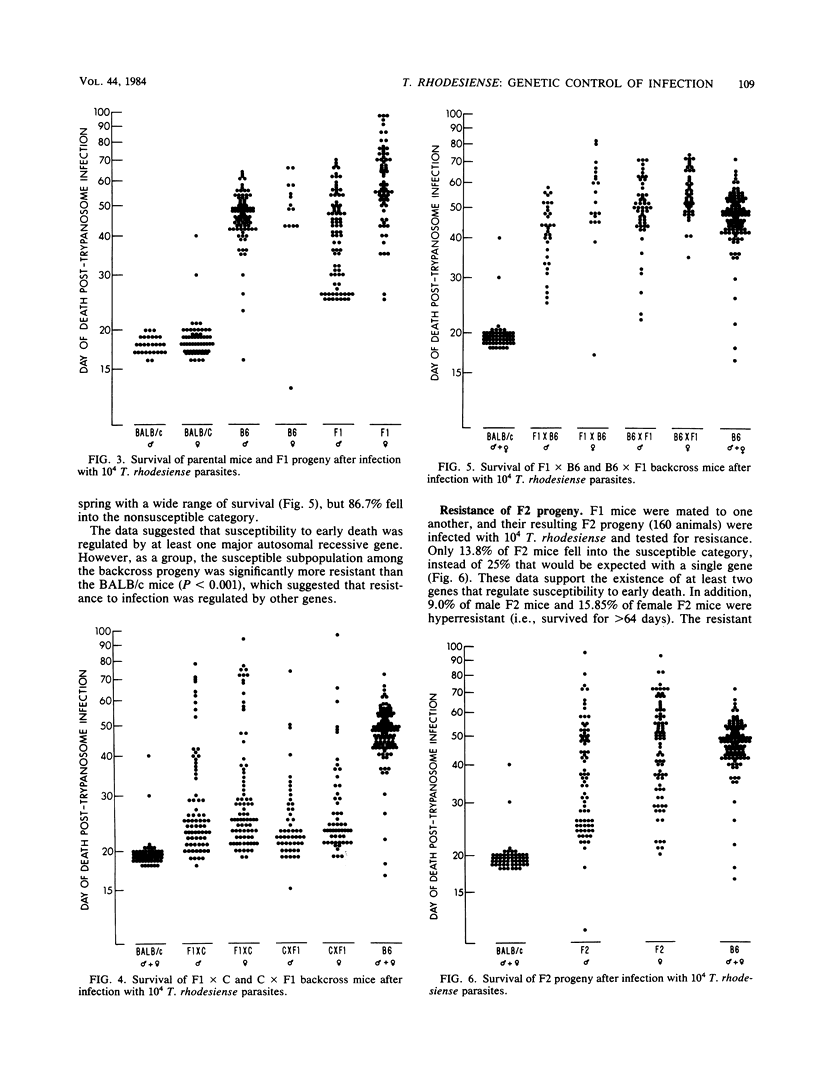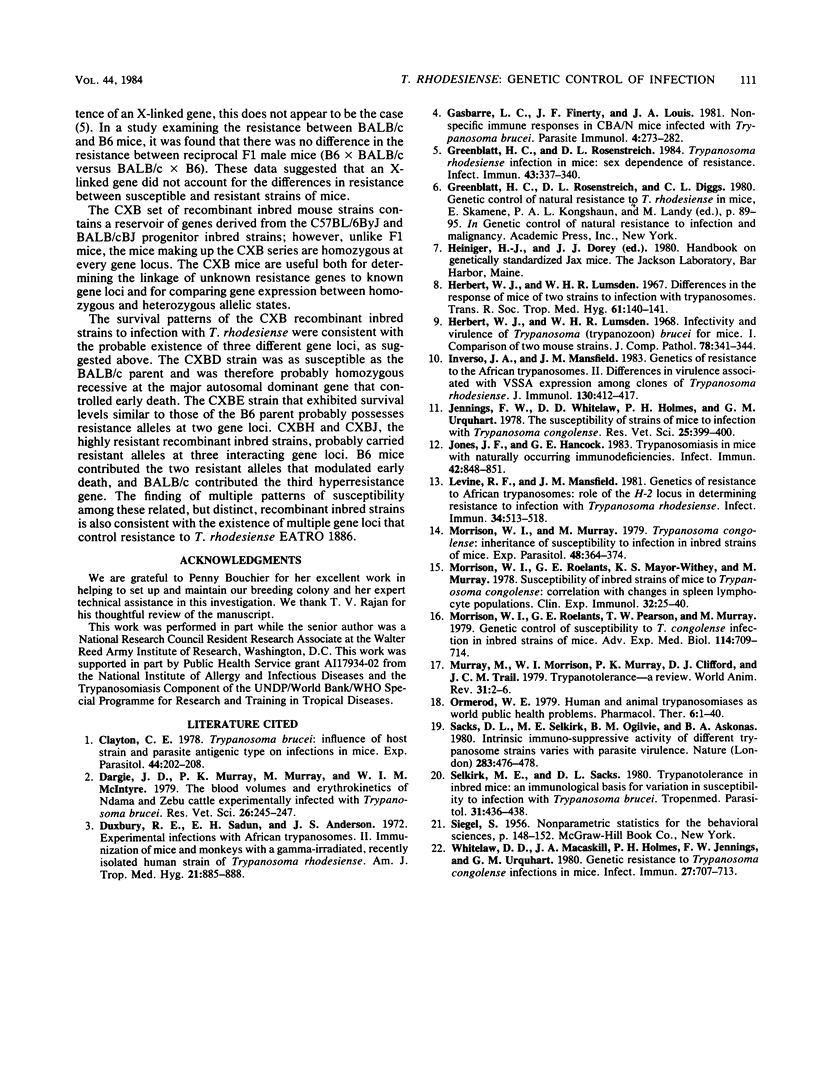Abstract
Inbred mouse strains differ in their resistance to infection with the human pathogen Trypanosoma rhodesiense. Of the strains tested, C57BL/6 (B6) mice were the most resistant, and BALB/c (C) mice were among the most susceptible. The genetic basis underlying the different susceptibility of these two strains was analyzed. (CXB6)F1 progeny of either sex were more resistant than the BALB/c parent. Also, the backcross of F1 mice to the susceptible male or female BALB/c parent resulted in 52.0% susceptible (i.e., death on or before day 24) progeny, as compared with only 0.64% susceptible F1 progeny. The data suggested that resistance was the dominant phenotype and that the resistant allele was carried by the B6 parent. The presence of another locus regulating resistance to death was suggested by the facts that only a small percentage of F2 mice were susceptible and that a number of F1 and F2 mice were more resistant than their B6 parent. The locus responsible for these phenomena was presumably hypostatic in nature and carried by BALB/c mice, and its effects were only evident in the presence of other resistance genes. In addition, the observation that many of the susceptible individuals among F2 and backcross mice were more resistant than the BALB/c mice suggested that other minor genes also modulated the response of mice to infection. A set of CXB recombinant inbred mice was tested as well, and the individual strains within this set could also be placed into four groups: susceptible, intermediate, resistant, or hyperresistant. These findings are compatible with the multigenic model suggested by the Mendelian analyses.
Full text
PDF




Selected References
These references are in PubMed. This may not be the complete list of references from this article.
- Clayton C. E. Trypanosoma brucei: influence of host strain and parasite antigenic type on infections in mice. Exp Parasitol. 1978 Apr;44(2):202–208. doi: 10.1016/0014-4894(78)90099-1. [DOI] [PubMed] [Google Scholar]
- Dargie J. D., Murray P. K., Murray M., McIntyre W. I. The blood volumes and erythrokinetics of Ndama and Zebu cattle experimentally infected with Trypanosoma brucei. Res Vet Sci. 1979 Mar;26(2):245–247. [PubMed] [Google Scholar]
- Duxbury R. E., Sadun E. H., Anderson J. S. Experimental infections with African trypanosomes. II. Immunization of mice and monkeys with a gamma-irradiated, recently isolated human strain of Trypanosoma rhodesiense. Am J Trop Med Hyg. 1972 Nov;21(6):885–888. [PubMed] [Google Scholar]
- Gasbarre L. C., Finerty J. F., Louis J. A. Non-specific immune responses in CBA/N mice infected with Trypanosoma brucei. Parasite Immunol. 1981 Autumn;3(3):273–282. doi: 10.1111/j.1365-3024.1981.tb00406.x. [DOI] [PubMed] [Google Scholar]
- Greenblatt H. C., Rosenstreich D. L. Trypanosoma rhodesiense infection in mice: sex dependence of resistance. Infect Immun. 1984 Jan;43(1):337–340. doi: 10.1128/iai.43.1.337-340.1984. [DOI] [PMC free article] [PubMed] [Google Scholar]
- Herbert W. J., Lumsden W. H. Infectivity and virulence of Trypanosoma (trypanozoon) brucei for mice. I. Comparison of two mouse strains. J Comp Pathol. 1968 Jul;78(3):341–344. doi: 10.1016/0021-9975(68)90011-x. [DOI] [PubMed] [Google Scholar]
- Inverso J. A., Mansfield J. M. Genetics of resistance to the African trypanosomes. II. Differences in virulence associated with VSSA expression among clones of Trypanosoma rhodesiense. J Immunol. 1983 Jan;130(1):412–417. [PubMed] [Google Scholar]
- Jennings F. W., Whitelaw D. D., Holmes P. H., Urquhart G. M. The susceptibility of strains of mice to infection with Trypanosoma congolense. Res Vet Sci. 1978 Nov;25(3):399–400. [PubMed] [Google Scholar]
- Jones J. F., Hancock G. E. Trypanosomiasis in mice with naturally occurring immunodeficiencies. Infect Immun. 1983 Nov;42(2):848–851. doi: 10.1128/iai.42.2.848-851.1983. [DOI] [PMC free article] [PubMed] [Google Scholar]
- Levine R. F., Mansfield J. M. Genetics of resistance to African trypanosomes: role of the H-2 locus in determining resistance to infection with Trypanosoma rhodesiense. Infect Immun. 1981 Nov;34(2):513–518. doi: 10.1128/iai.34.2.513-518.1981. [DOI] [PMC free article] [PubMed] [Google Scholar]
- Morrison W. I., Murray M. Trypanosoma congolense: inheritance of susceptibility to infection in inbred strains of mice. Exp Parasitol. 1979 Dec;48(3):364–374. doi: 10.1016/0014-4894(79)90121-8. [DOI] [PubMed] [Google Scholar]
- Morrison W. I., Roelants G. E., Mayor-Withey K. S., Murray M. Susceptibility of inbred strains of mice to Trypanosoma congolense: correlation with changes in spleen lymphocyte populations. Clin Exp Immunol. 1978 Apr;32(1):25–40. [PMC free article] [PubMed] [Google Scholar]
- Morrison W. I., Roelants G. E., Pearson T. W., Murray M. Genetic control of susceptibility to T. congolense infection in inbred strains of mice. Adv Exp Med Biol. 1979;114:709–714. doi: 10.1007/978-1-4615-9101-6_117. [DOI] [PubMed] [Google Scholar]
- Ormerod W. E. Human and animal trypanosomiases as world public health problems. Pharmacol Ther. 1979;6(1):1–40. doi: 10.1016/0163-7258(79)90055-x. [DOI] [PubMed] [Google Scholar]
- Sacks D. L., Selkirk M., Ogilvie B. M., Askonas B. A. Intrinsic immunosuppressive activity of different trypanosome strains varies with parasite virulence. Nature. 1980 Jan 31;283(5746):476–478. doi: 10.1038/283476a0. [DOI] [PubMed] [Google Scholar]
- Selkirk M. E., Sacks D. L. Trypanotolerance in inbred mice: an immunological basis for variation in susceptibility to infection with Trypanosoma brucei. Tropenmed Parasitol. 1980 Dec;31(4):435–438. [PubMed] [Google Scholar]
- Whitelaw D. D., Macaskill J. A., Holmes P. H., Jennings F. W., Urquhart G. M. Genetic resistance to Trypanosoma congolense infections in mice. Infect Immun. 1980 Mar;27(3):707–713. doi: 10.1128/iai.27.3.707-713.1980. [DOI] [PMC free article] [PubMed] [Google Scholar]


